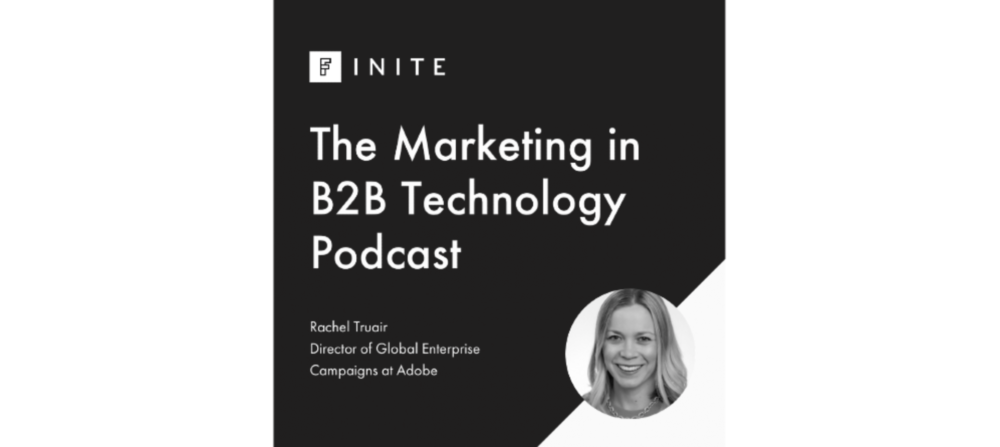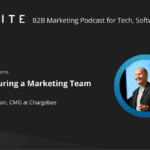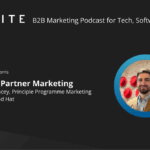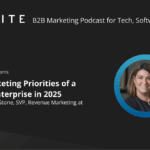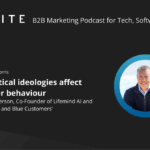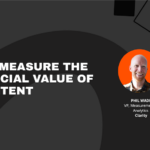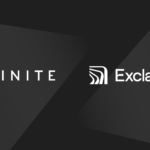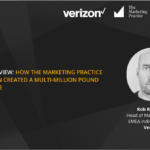In this FINITE podcast our host Alex sat down with Rachel Truair, Director of Global Enterprise Campaigns at Adobe to discuss the strategies behind building a springboard for lasting growth. The conversation focused on how during a challenging time, such the coronavirus pandemic, marketers can look at the current landscape, think about how they communicate and how they foster loyalties with their customers.
This episode covers:
- About Rachel and her career in marketing
- The value in a formal qualification for marketing
- What it means to build a springboard for growth
- How marketing strategies have been impacted by Covid-19
- How Adobe has adjusted their marketing strategy due to Covid-19
- Sales and marketing alignment of increasing importance due to the pandemic
- How a start up can scale during the pandemic
- How Rachel is adjusting her marketing strategy for customers working from home
- Why the ‘buy from us’ message no longer works
- Current blindspots in data as people work from home
Listen to the full episode below:
And once you’re done listening, find more of our B2B marketing podcasts here!
Disclaimer: The views and opinions presented in this podcast belong solely to the interviewee and do not reflect an official statement or opinion of the author’s employer, past employers, or any other organization or committee this interviewee may have been, currently is or will be affiliated with.
Full Transcript
Alex (00:07):
Hello everybody and welcome back to another episode of the FINITE podcast. So today I’m going to be talking with Rachel Truair. Rachel is joining us from Austin in the US where she works for Adobe. She’s the Director of Global Enterprise Campaigns on the commerce side of the Adobe business. And we’re going to be talking about building a springboard for growth and how during a pretty challenging time, marketers can look at the current landscape, think about how they communicate, how they foster loyalties and hear some examples of how Adobe have been doing that themselves. I must also add the statement that the views and opinions presented in this podcast belong solely to Rachel as the interviewee and do not reflect an official statement or opinion of the author’s employer, past employers, or any other organisation or committee this interviewee may have been currently is, or will be affiliated with. So with that out of the way, I hope you enjoy this episode.
FINITE (01:00):
The FINITE community and podcast are kindly supported by 93x, the digital agency working exclusively with ambitious fast growth B2B technology companies visit 93x.agency to find out about how they partner with marketing team and B2B technology companies to drive digital growth.
Alex (01:21):
Hi, Rachel, thanks for joining me today.
Rachel (01:23):
Thanks for having me.
Alex (01:25):
I’m looking forward to talking with you. I know this feels like it’s going to be hopefully an optimistic and positive look at the future and ongoing growth given the kind of circumstances that lots of marketers find themselves in. But before we dive into that as a subject, as we always do, it’s nice to hear a little bit about your background, how you got into marketing and kind of experience so far. And of course, a little bit about what you’re up to at the moment.
About Rachel and her career in marketing
Rachel (01:49):
Sure. Sounds great. Well, thanks again for having me. I’m Rachel Truair I’m based in Austin, Texas, and I’m currently at Adobe in their digital experiences business unit. And how I got into B2B marketing is really, I started off more on the B2C side in startups and was working as a marketer with a lot of different marketing automation platforms and technologies. And my original kind of foundation was really in content marketing.
And I had a ton of success kind of in the early 2000s leveraging content marketing to drive inbound demand, both through organic search terms and also just social and paid search. And so I kind of pivoted into B2B tech marketing because I was an avid power user of a lot of different marketing automation programs. And I realised as a marketer what great work I could do with technology. And it kind of made me excited to be able to tell that story as a B2B marketer.
And it gives me kind of a perspective now in my role to kind of think about the customer on the other side of the marketing that we’re doing. And we’ll talk a little bit about that today. Just some of the interesting things I think that’s happening for marketers that are evaluating technology or looking to technology during this time to support their businesses. In terms of, you know, companies I’ve been at, I started in startups, as I mentioned.
And then I pivoted my career at really the large enterprises during my MBA that I was doing at the University of Texas and went briefly as a kind of MBA contract role too 3M, which is a huge manufacturing global company that has a large presence in Austin and worked in their interactive marketing organisation there, and then moved from there to Oracle, where I was in the Oracle Marketing Cloud Group, and really learned a lot about enterprise sales and kind of best practices around both inbound, but also outbound marketing and how marketing can work closely with the sales organisation to drive know results in target accounts.
And then from there, I went onto Magento Commerce, which was a fast growing company in 2017 and got to really learn a lot about the eCommerce space, which is, as you know, just a huge opportunity, both on the B2C and now emerging more and more on the B2B side as kind of those, those lines blur and lead America’s Marketing Organisation at Magento.
And then in 2018 Magento was acquired by Adobe and had a great opportunity to kind of move into the larger Adobe ecosystem, really telling the Magento story in the enterprise space. So now Magento, we have Adobe Commerce Cloud, which is a really integrated solution across Adobe’s different products that allows commerce users to, in large enterprises, to really scale and have the flexibility that they need to do that. And so I work in our marketing organisation driving global campaigns.
Alex (04:47):
How did you find that that kind of transition from B2C to B2B? Cause I see so many job specs, which like five years of B2B marketing experience and it’s like, I’ve never really believed in the kind of really siloed approach to you can’t do one or the other, unless you’ve done them before.
How did you get the first shot and was it important and did people kind of, did you feel set back by only having B2C experience?
Rachel’s first shot at entering B2B from B2C
Rachel (05:10):
You know, it’s interesting, I kind of agree with you in that respect because in the B2C space I was in, a marketer would probably call it considered purchase space. So while we were marketing directly to consumers, we had a longer sales cycle and we were selling more of a services package.
So in terms of our marketing it was actually very similar to how we look at B2B marketing. We had nurtures, we had opportunity qualification processes. We had lead gen on the front end. So in many ways it was, it was much more similar to B2B the main difference for sure, when I got into, especially Oracle was just the sales process in terms of field sales and being really aligned with that motion and making sure that what we’re saying on the marketing side was getting driven out through the field as well.
So I found that at the end of the day, you’re usually assigned to an individual, whether it’s a group of individuals, that’s an account or an individual that you’re selling to on the B2C side and the more personalised and relevant and contextual you can be, the better you’re going to do.
Alex (06:09):
Interesting. And just quickly before we dive into things, you mentioned the MBA. I’m always really interested and I think our listeners are in terms of like marketing focused education here in the UK, I’m sure in the US there’s just such a huge breadth of different things from one day courses to three month courses to full MBAs with a marketing focus.
Did you have kind of a marketing specialism within the MBA or was it more general? And do you think it’s helped with your kind of overall marketing experience and career?
Formal education for marketing
Rachel (06:34):
It was more general. It was actually an executive MBA, which was at UT they have a two year program. It was in person and kind of designed for mid to senior level people that were looking to broaden their view of organisations. And so I actually loved the fact that it had a really diverse curriculum and some of the things as a marketer that intimidated me prior to my MBA was just some of the concepts around finance and accounting specifically.
And I will say that it really helped me kind of grasp, especially when it comes to a publicly traded company, how they look at their balance sheets, how they are looking at their filings that they submit. And it made me a lot more confident in the marketing that I was doing. And also being able to really understand the kind of where a budget, a marketing budget might fit in to an overall financial strategy that organisations have.
So while I expected to really love the marketing related courses in my MBA, actually the thing I learned the most about myself was that I really enjoyed all of my finance and economics classes. So it was kind of a cool experience. And I will add that in the States, at least my experience has been that marketing curriculum is pretty dated.
I actually, right after I finished my MBA I actually taught as an adjunct professor at a private Catholic university called Saint Edwards. I taught a marketing communications class and I looked over the curriculum that was presented by the professor before me. And it was just extremely dated in terms of its content. And so I, I kind of re evaluated it and ended up introducing a couple of new books to the program and designing a marketing communications class that was more geared around how marketing happens today.
And the students, I got really positive feedback from because there was so much that they were witnessing in their daily lives in terms of targeting and advertising that no one had ever explained to them how you, for example, a DMP might work or why they were seeing these ads all the time and then suddenly they went away. And so we really got into how that kind of digital space, what it looks like and the vast technical landscape that exists around marketing that I think was really eye opening for them.
So I think it’s a gap in education right now that there’s not some of these newer concepts as marketing has evolved. I don’t think the curriculum always has.
Alex (09:00):
Yeah. I think it just moves so fast that by the time you’ve probably written your curriculum, it’s potentially out of date in some areas, right? Or the platforms changed and our targeting systems and like it moves so quickly. So yeah, I don’t envy anyone trying to get curriculums up to date in that space.
Rachel (09:14):
Yeah. Someone’s probably trying to update my curriculum to Talk:101 or something at this point.
Alex (09:20):
So let’s dive into building a springboard for growth. I know we obviously find ourselves talking in a slightly unusual time with everything that’s happening in the world. I guess it’s a challenging time for marketers in general. I guess some marketers have had budgets paused or cut entirely. Some businesses will never be the same again, if they do survive others, growth is still important if they can grow at all.
So I guess this is a subject which is almost company by company, very personal to the organisation that listeners might find themselves in. But I guess in broad terms, when you talk about building a springboard for growth at a time like this, I guess what do you mean?
Building a springboard for growth
Rachel (10:02):
Yeah. Well, I think it goes about saying that marketers in this moment that we’re in are being asked to do more with less than they ever have before. And especially we know from some recent research, Deloitte did that around 40% of CMOs were already saying, going into last year 2019, that growth was the number one priority on their agenda for the year.
So knowing that, and now here we are in 2020 with you know, various impacts in terms of operational functionality and just being able to tackle marketing in this economy. We’re now having to do even more and grow even more, fill gaps that maybe we didn’t have before and look at really the strategy and say, where do we need to prioritise to be able to do more with less?
So in terms of building that springboard, it’s really about thinking about what are the key areas to focus on and how can you get your marketing organisation really aligned to be able to do that, and also stay in that process, stay true to your brand and really be able to kind of cut through the noise in a time where people are quite distracted and challenged to be paying attention really, to anything.
Between trying to take care of their children at home, or trying to just get through, maybe getting online groceries even, you know, has become a challenge for many. So being able to have your brand shine through is even harder than ever.
Alex (11:30):
I guess that means that, and this sounds very similar to lots of conversations I’ve had with FINITE members and just marketers I’ve been talking to generally, but that kind of top of funnel, brand building activities where a lot of the focus is, I guess the general feeling has been that people aren’t ready to kind of click buy on whatever these B2B organisations might be selling, but it is a really good opportunity to educate and to entertain sometimes. Business that haven’t had a strength of brand in the past have caught themselves in the open and maybe are scrambling to get a lot of that stuff together.
We’re saying a brand is more key than ever at a time when, if your customer doesn’t want to buy from you, you need to engage with them in a kind of softer touch way?
How marketing has been impacted by Covid-19
Rachel (12:19):
Yeah. So it’s interesting because, you know, with this pandemic, we’re seeing these huge swings, for example, companies that were doing really well leading into the pandemic might now be really not doing so great and companies that were just maybe having steady or flat growth suddenly are seeing these swings upward.
So I think what’s interesting about it is that you have companies trying to either course correct from being affected negatively by the pandemic or very quickly scale and grow and maybe ramp up projects that they have put on a back burner due to resource limitations now that they have this opportunity right in front of them.
So I’ll just give you two examples. You know, I actually have a friend who’s a marketer for a rice company and obviously rice is a steadily growing kind of commodity that’s been around a long time. You know, they were introducing product innovation and new ideas and recipes prior to the pandemic. But when the pandemic hit suddenly their rice was flying off the shelves.
So what she’s looking at right now is they had already been starting to invest in some projects such as looking at whether or not they could do B2B eCommerce, where they use eCommerce to fulfil orders to their suppliers that they’re selling their rice through. But now what they’re starting to think about is okay, all of these people came and bought all of our rice during the pandemic, but what happens six to 12 months from now, when maybe things start to kind of look like going back to normal and they have tons of rice on their shelves, how do we help them maybe use that rice to think through what they’re doing with it? How do we continue to grow past this time? So that’s one example.
The other flip side might be, think of a luggage company where they might’ve been doing extremely well. Travel has been booming for the last few years, just with social media and millennial trends. So now suddenly luggage companies are kind of looking at how do we kind of address what’s going on? How do we pivot? You know, a lot of them are starting to innovate in terms of the product offering that they have.
And even B2B companies that might be looking at, okay, maybe we’re seeing a slow down in some of our growth, but we still need to be able to communicate well to our customers and prospects. And so that might look like more of a marketing automation play, where they’re trying to figure out how do we get more personalised when we’re talking to people or how do we understand better what they’re looking for or what they’re trying to do next? How do we bring that data in and then market to them in a really relevant way?
So I think it’s so interesting to see kind of these big swings happening and even companies that are not doing so well, they’re still having to figure out how do they adjust and really across both of those, being able to be a good corporate citizen is so essential right now. And I think a lot of that comes through in communication. So, you either have companies that are trying to really tell this inspirational positive message.
And then I think the other flip side of it is being able to really offer a helping hand. So you can see really great communication coming from brands that are being very inspiring. And you can also see really great communication in terms of resources and advice, or even plans and policies that might be more flexible. Both of those things are really resonating in the market right now. And I think no matter what, whether you’re a B2B market or B2C marketer, you’re a B2C company, you know, retail, whatever it is, that’s really being able to hit that right mark between those two areas is kind of the sweet spot.
Alex (15:48):
That makes sense. I think we’ve all been on the receiving end of so many emails, and I think everybody’s probably had plenty of examples of what good looks like and what bad looks like in terms of the kind of messaging that’s being sent out by email directly in relation to Coronavirus, I guess.
Rachel (16:04):
Yeah. It’s a great time for, if you are having some breathing room to kind of look at your content and do a real content audit of what still resonates in the market and what doesn’t and think about all the different channels where your content may be running yeah. Out of home, direct mail, it could be digital advertising, but making sure that everything that you are putting out into the market, is still relevant and is still sensitive to the current environment.
I saw a funny tweet the other day that said that prior to the pandemic advertising was, you know, buy a car and now it’s just times are hard, buy a car. And so making sure that you’re not just kind of sticking on this pandemic messaging on top of an existing message, but really refining it. So that it resonates, but also is coming from a place of honesty and it doesn’t look like it’s just kind of a fast, quick bandaid I think is so important.
Alex (17:00):
Yeah, I think that’s good advice. I guess there’s an opportunity, particularly in the B2B technology space for companies to build a lot more loyalty with their customers or with their potential customers in all kinds of different ways.
And this was actually something that I talked about with April Dunford, who was on one of our previous episodes and does a lot of work around positioning. And we were talking about how some kind of cheaper SaaS products that you might be paying, you know, $9.99 a month or something they’re often the ones that they as companies think, oh, we’re so cheap that no one’s going to cut us, but actually they’re the things that are first to go if they’re non-critical and they’re the easiest to turn off.
But I guess more broadly, I’m interested in your thoughts on, we’ve seen a lot of companies kind of offering three months free or their tiers so that you get more from them for the initial periods. Do you think that’s something, is that something you’ve been exploring at Adobe in general or is that something that can work?
I guess the flip side is, does it potentially devalue what you do and does it make you, I guess from a marketing perspective, it can sometimes make you look a little bit needy or like you might be struggling. And so you’re trying to do what you can to bring in customers. I think it’s quite a fine line to walk.
How Adobe has adjusted their marketing strategy due to Covid-19
Rachel (18:13):
Yeah, we’ve definitely not only looked at a lot of that, but started to implement quite a bit of it. We’ve rolled out some payment plan options and also some offerings that basically allow companies to defer costs of ownership further out into the future. So I think there’s ways to do it where you’re not necessarily giving things away for free, but instead recognising that this is unprecedented in terms of what’s happened to most companies’ cash flows and understanding that, you know, things will eventually level off or people will adjust to be able to adjust their cash flows accordingly.
And so not necessarily giving everything away for free, you do want to have that value, but being flexible. And I think also the other thing to think about Magento, as a part of Adobe has this huge ecosystem of partners and developers that because of Magento’s roots as an open source technology are very involved and also very affected by this.
You know, if things are not going well in the economy, our ecosystem is feeling the result of that. And so we thought about it in terms of not just our solution and our customers, but also our broader ecosystem. We’ve actually just this week, I can share a link with you about, for more detail about it, but we’ve rolled out some options around our developer’s ecosystem, being able to continue to contribute to our product during this time where they may not have any other work.
So it’s basically bringing not just our customers along and our prospects, but also thinking about the ecosystem around us. And I think for most B2B companies in general, there’s some kind of partner element to what they’re doing.
And so thinking about more broadly, the impact on partners and how that can be improved and how you can make sure that when things do kind of start to ramp up or get back to normal, you haven’t lost this really valuable element, which is your partner ecosystem in that because, you know, these are usually smaller companies and they can’t always sustain, you know, staffs and groups of engineering teams during difficult times.
So I’ve just been very impressed with a lot of the strategy around this that Adobe has thought through and quickly implemented. And then on the marketing side, it’s really about how do we amplify that message, right? How are we making sure that people hear about this? And also our sales team is aligned with us and they understand what the message is. And it’s really a cross functional organisational effort to really get that out into the world in a way that’s genuine.
Alex (20:44):
I think one thing that’s come up quite regularly in my discussions with marketers, is that they felt like as though sales and marketing are becoming much more naturally aligned as a result of everything that’s happening at the moment in terms of needing to stay close to customers and communicate the kind of things that you’ve been talking about. Would you say that’s a fair summary?
Sales and marketing alignment
Rachel (21:01):
Well, you know, I think in well-functioning enterprise or even mid market technology organisation, you really do want title alignment between sales marketing, no matter what’s going on. I do think that one of the great things about working with sales is that you’re in the boat with them.
You know, as a marketer, you might be driving a lot of top of funnel demand, or maybe you’re in field marketing and you’re helping accelerate demand. But at the end of the day, you really need a strong sales organisation out there closing deals otherwise you probably don’t have a job, right? And so having that alignment is so important in the best of times. And in the worst of times, it’s good to already have those strong relationships.
And I’m hopeful that people that maybe, maybe there was a disconnect before that they’re starting to kind of come together, but in most organisations I’ve been, I’ve always tried to make sure that we have close alignment with sales, no matter what’s going on, because that’s how the, that’s really so important to being able to get to everybody’s goals.
Alex (22:01):
Yep. Makes sense. I’m interested in your perspective. Obviously Adobe is pretty well known and there’s just so many different components of the business and you’ve got a voice and a brand that’s recognized around the world. If you’re a small, I dunno, 30 person, SaaS company, that’s just raised a Series A and is going for growth.
Do you think a lot of the same things can still apply or do you think it’s a fairly different situation? And I guess, do you think there’s things that you’ve talked about in terms of deferring payments and offers that are kind of directly related to the current situation can still carry weight and add value, obviously assuming that they can, they can afford to do that as a startup, the scaling.
How can a start up scale during the pandemic?
Rachel (22:43):
Yeah. I mean, I think that these are kind of bread and butter type ideas in terms of being able to kind of bridge the gap during this time. Obviously having a strong business model is important, no matter what’s going on kind of like sales alignment, you’ve just got to have it. And the work has to be done, whether times are good or bad.
I do think one thing that’s been interesting to me to see happening in the marketing organisation at Adobe is that we’ve started to shift resources in terms of doing more with less and having people helping with projects and activities that maybe they weren’t helping before. And one of the things we actually have going on is kind of a option for people to volunteer for projects that need to be done.
We’ve scoped out the work in terms of how many hours a week someone might need to have to contribute to that work, who the person that they would be, you know, quote unquote reporting to/working with in that project and what the objectives of that project might be. So it’s giving people an opportunity, someone that works in campaigns might have an opportunity to go work on the customer marketing side of things or someone that’s working more on the demand side and has always wanted to learn more about kind of online communities might have an opportunity to go pitch in and help in the community space.
So even things like that, where if you have a team and you can organise well enough to be able to identify how you can get everyone working cross functionally to pitch in and drive the business forward. I think innovation is no matter how big of a company you are, is always possible. And in fact, many times it’s smaller organisations sometimes easier, right there, you can move more quickly. There’s less red tape.
So I would encourage smaller organisations to really think about how can they step outside the box of what they’ve always done during this time? Even if they’re a new company, they’ve only been around for a couple of years, you do get into these habits and frameworks that seem very locked in, but in this kind of time of disruption, it’s a great opportunity to kind of try different things.
And this is kind of special projects motion that we have going on right now is one of those activities that if it wasn’t for the pandemic might not have ever been brought up or organised. So it’s a really cool thing to see. And I’ve got people on my team saying, hey, I’m thinking about doing this special project. And you know, it’s not leadership coming down and saying, hey, everybody, you have to go work on this now. It’s voluntary, it’s something that makes people feel empowered and it’s giving them opportunity to expand their skills while also pitching in and helping other team members and ultimately helping the bottom line and drive the business.
Alex (25:16):
I think, I mean, that sounds like it reflects the culture that you have as an organisation, as much as the situation, I guess. And I don’t think that would happen in every company, but I think that’s a really positive way of keeping people engaged and busy on things. Even if their specific area of marketing might be slightly on pause or not as active as it has been in the past.
It sounds like you’ve been doing a lot to support customers generally in lots of different ways, but I assume you’ve been doing a degree of your own kind of planning and continuity planning. Obviously it’s great to hear that you’re in a position to help customers and support them and defer payments and all kinds of great things that as you say, bring customers in the whole ecosystem along with you, and I think will build trust in that relationship with you for years to come.
But at the same time, you know, you’ve said you’ve been having to do more with less, and I assume your own degree of planning and forecasting. What’s your kind of outlook at the moment?
How Rachel is planning her marketing strategy for customers working from home
Rachel (26:10):
Well, like I said, I mean, you’ve got these really dramatic swings happening where maybe a segment or an audience that you were previously targeting and focused on is not growing now that was growing before. But there’s this other segment and audience that suddenly is. So being able to, as part of that planning really pull those insights out.
We’re spending a lot of time looking at data, understanding where the trends are shifting and then reacting in a way that’s both strategic, but quick, is what we’re doing right now. And I think it’s been great, being in a company that focuses on driving digital experiences and creativity, it’s a really interesting time to be able to apply both creativity and also rethink digital experiences in general and how we do them. It’s created a lot of new ideas.
And for example next week we have a, we’re calling it a Magento mixer, but it’s basically a virtual cocktail mixer event that we have going on where we’ve hired a celebrity mixologist in New York city. We’re sending out little kits of cocktails and some other goodies to prospects and customers and even some of our sales team and leadership. And then they’re all going to be able to come together and experience this celebrity mixologist and some new cocktail ideas while everyone’s socially distant. And so these things probably would not have been thought of before, not things that we were really doing before, at least not virtually, but they’re fun ways to kind of help support other people.
Another thing that we’ve started doing, one of our customers on the Magento side, little passports, it’s kind of a subscription service that sends educational materials for children about different parts of the world and different cultures. We’ve been sending boxes of those to prospects and customers with children just as a thank you and giving them something that they can give to their children and entertain them for a couple of hours, just as a nice thinking of you piece of mail.
And so just little ideas like that, that are bubbling up across the organisation. As we look at the data and shift some of our messaging and our strategy, but, there’s, there’s a lot of really companies that are actually doing quite well during this time that need to figure out how do we do more digital experiences? How do we communicate with customers? How do we sell online to customers better and more quickly and in different countries? And so that’s where there’s a lot of opportunity.
Alex (28:43):
Do you think that now is the time to be, I guess in terms of the more bottom of funnel stuff, and really, I know it’s going to be very industry specific and company specific, but do you think attention is best focused on the general kind of top of funnel, educate, entertain, please people, provide them with useful content?
And then you’re kind of at the front of the grid when the lights turn green again, and I don’t think it’s gonna happen overnight, it’s going to be a gradual build up. But I guess a lot of the feedback I’ve been hearing is people don’t really want to buy right now, but they are happy to hear from us in some form. So now’s the chance to I guess, build the pipeline.
And you mentioned earlier, like personalisation and nurturing and all the things you can do to really optimise that side of things, but people are avoiding the more hardcore ‘buy from us’ message. And what’s your perspective on that?
The ‘buy from us’ message
Rachel (29:35):
Well, I think that the ‘buy from us’ message was dead long ago, long before the pandemic. It was something that worked for a brief period of time many years ago. But if anything, we’ve learned as marketers over the last few years that you really have to nurture and provide relevant information and personalise information to your prospects. And if there is a budget and a need and a timeline, eventually they will buy, they will raise their hands in some meaningful way and they’ll convert to being a prospect and then a customer.
So I think the ‘buy from us’ message was never a good fit in recent times. And especially now of course it’s not a good fit. And so it’s more about how do you take that nurturing message and adjust it for today’s world? So even topics like continuity and business continuity and how do you help serve them and share some of these ideas that we’re talking about with your customers is a great way to do that.
You know, we hosted a series of coffee chats with the American Marketing Association a couple of weeks ago, talking about many of these same things. So things like that that can help guide people during this time is what I would say that the new message is, and if there’s a project in a pain point, just like in normal times, that will surface.
Alex (30:56):
That sounds like a pretty generally inbound way of doing marketing, which is, I think I’ve always believed in too, which is kind of position yourself as the experts and the thought leaders and as you say, if the case arises for a need and a pain point and a budget and a timeline, then you’re kind of, you’re the ones that they will turn to when the time is right.
Paying attention to data blindspots
Rachel (31:17):
I think one interesting thing that B2B marketers are trying to understand right now is so much of what’s been going on from a nurture standpoint was driven by intent based data. And because so many people are like ourselves, now working from home, they’re not on their corporate IP addresses. They’re not sitting in their offices. They may not be answering that phone number that is associated with their account. So some of the data challenges I think are very interesting coming out of this.
And I think making sure that what you’re looking at is not leading you astray is very important. And especially if you’ve been marketing at an account based level. So I would encourage other marketers that are working in this B2B space that do have account-based strategies to take a hard look at their data and make sure that it’s telling them the right story and a real story, because they may in fact, still be getting prospect information and interest on their website or their blog or in their emails, but it may not be lining up with that account anymore. And it might create some confusion there.
So it’s a blind spot that marketers should be aware of right now. There’s definitely ways around it. And ways to kind of still hone in on who you’re speaking to, maybe pivoting a little bit more to some of the social network platforms where you can actually target specific accounts based on form fills that people have filled out and that kind of thing. But I think making sure that you’re paying attention to that is really important right now,
Alex (32:49):
HubSpot are doing a weekly update on their general trends from across their 70,000 or so customers and how many emails are being sent and deals closed and deals added. And that seems huge the big uplifts in website traffic generally across their sites. But I looked at that and just thought, that’s probably just people working from home and not having their IP dynamic IP, not filtered out from analytics.
So HubSpot’s reporting these kind of huge uplifts in website traffic, but it’s probably just people visiting their own site and managing their own. Yeah, because everyone’s, I guess in an office you’re on a static IP, which is always the same and you can filter out, whereas at home, I guess it’s the same in the US but here in the UK, your IP address might jump around based on when you log in. You know what I mean?
So, yeah, I guess keeping an eye on the data, making sure you know what you’re looking at is really important at the moment for sure.
Rachel (33:39):
Yeah. My home IP address often says I’m in an entirely different state, which I don’t quite understand. So, I mean, yes, you might be, you might be finding the wrong person, if you were looking at mine. But yeah, it’s an interesting thing to think about, for sure.
Once you start really looking at all the dots that are connected with that, there’s a lot of things that could be impacted; lead scoring, nurture triggers, if you have any kind of real time automation happening, just making sure that that’s all been assessed is important.
Alex (34:09):
That’s a good practical tip. Well, I think there’s a lot there. That’s really interesting, useful, and it’s really good to hear what you’ve been doing at Adobe. And I guess overall sounds like you’re bleeding from the front and setting a pretty good example of what you’re doing with your own marketing, but also I think a good example for lots of other businesses to follow too, which is great. So yeah. Thank you so much for sharing some of those tips.
Rachel (34:30):
Yeah. Thank you. Thanks for having me. And I do also just want to say a quick thank you to all of our frontline and essential workers. I think, you know, they’re doing such amazing work and making it so that us B2B marketers can stay home and worry about these other things, but really big, thank you to the people on the front lines.
Alex (34:47):
Yeah, that sounds a priority at the moment. So yeah, I agree with that. Thanks Rachel.
Rachel (34:52):
Thanks Alex.
FINITE (34:54):
Thanks for listening. We’re super busy at FINITE building the best community possible for marketers working in the B2B technology sector to connect, share, and learn along with our podcast. We host a series of events here in London, so make sure you head to finite.community to subscribe and keep up to date with upcoming events.
